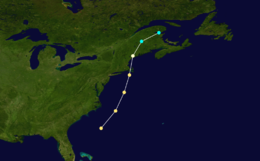Saxby Gale
| Category 2 hurricane (SSHWS/NWS) | |

Path of the Saxby Gale
|
|
| Formed | October 4, 1869 |
|---|---|
| Dissipated | October 5, 1869 |
| Highest winds |
1-minute sustained: 105 mph (165 km/h) |
| Lowest pressure | 965 mbar (hPa); 28.5 inHg |
| Fatalities | 100+ direct |
| Areas affected | Massachusetts, New Hampshire, Maine, New Brunswick, Nova Scotia, Prince Edward Island |
| Part of the 1869 Atlantic hurricane season | |
The Saxby Gale was the name given to a tropical cyclone which struck eastern Canada's Bay of Fundy region on the night of October 4–5, 1869. The storm was named for Lieutenant Stephen Martin Saxby, a naval instructor who, based on his astronomical studies, had predicted extremely high tides in the North Atlantic Ocean on October 1, 1869, which would produce storm surges in the event of a storm.
The hurricane caused extensive destruction to port facilities and communities along the Bay of Fundy coast in both New Brunswick and Nova Scotia as well as Maine, particularly Calais, St. Andrews, St. George, Saint John, Moncton, Sackville, Amherst, Windsor and Truro.
Much of the devastation was attributed to a 2-metre storm surge created by the storm which coincided with a perigean spring tide; the Bay of Fundy having one of the highest tidal ranges in the world. The Saxby Gale storm surge produced a water level which gave Burntcoat Head, Nova Scotia, the honor of having highest tidal range ever recorded. It is also thought to have formed the long gravel beach that connects Partridge Island, Nova Scotia, to the mainland.
The storm also produced waves which, combined with the storm surge, breached dykes protecting low-lying farmland in the Minas Basin and the Tantramar Marshes, sending ocean waters surging far inland to inundate farms and communities. Sailing ships in various harbors were tossed about and/or broken up against wharves and breakwaters which were also destroyed. Farmers trying to rescue livestock from fields along shorelines drowned after dykes were breached; over 100 people were killed in the Maritimes alone. The gale destroyed miles of the newly completed Windsor and Annapolis Railway along the Minas Basin near Horton and Wolfville, Nova Scotia.
...
Wikipedia
